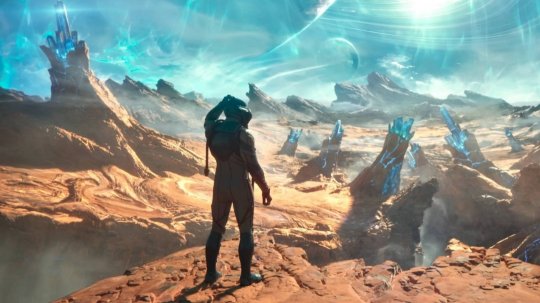New Mars images show the Red Planet's 'Inca City'
A European spacecraft orbiting Marshas acquired some of the most detailed images yet of a region at the Red Planet's south pole known as "Inca City."
How this mysterious place earned its nickname is 关键字3pretty obvious: From space, the natural grid-like pattern of pin-straight ridges, right angles, and polygons looks like the ruins of Machu Picchu in Peru. Though NASA's Mariner 9 spacecraft discovered this area— more formally referred to as Angustus Labyrinthus — 50 years ago, planetary scientists are still unsure what natural phenomenon drove its formation.
"It could be that sand dunes have turned to stone over time," according to the European Space Agency, which runs the Mars Expressorbiter. "Perhaps material such as magma or sand is seeping through fractured sheets of Martian rock."
Or, in another possible theory, the ridges could be winding structures related to glaciers, the agency said. The German Aerospace Centre, whose High Resolution Stereo Camera shot the photos, believes the most compelling explanationis that the narrow ridges are solidified lava.
SEE ALSO: NASA asks: Can anyone help us get our Mars samples back?This Tweet is currently unavailable. It might be loading or has been removed.
The features that resemble walls appear to trace part of a 53-mile-wide circle. Scientists think perhaps the "city" sits in a large crater from an ancient asteroid collision. The impact may have caused faults to spread through the surrounding plain, filled with magma bubbling up.
"Later, the softer material surrounding the polar plains was eroded, leaving behind ridges of the harder components of magmatic rock," the German Aerospace Centresaid.
Mars Express has taught scientists a lot about the Red Planet over the past 20 years. The spacecraft has been observing the Martian surface, mapping its minerals, revealing its composition and other aspects of its environment.
 An area at Mars' south pole region has been compared to these ruins at Machu Picchu in Peru. Credit: joSon / Getty Images
An area at Mars' south pole region has been compared to these ruins at Machu Picchu in Peru. Credit: joSon / Getty Images The new photos also found hints of spidery formations scattered over the polar region — features that are better understood by researchers than Inca City. Dark splotches seen in the image below are buried "spiders," or so-called araneiform terrain.
Related Stories
- An enormous Martian cloud returns every spring. Scientists found out why.
- What Mars would look like from an orbiting space station
- How Mars rovers could explore vast uncharted caves
- NASA rover finds clear evidence of ancient waves, yes waves, on Mars
- Mars isn't as red as you might have thought
The spiders tend to emerge when spring sunlight shines on layers of carbon dioxide deposited over the dark winter. The sun causes the dry ice trapped below the ice cap to turn into gas, which eventually breaks through the ice.
 The grid-like ridges of the Angustus Labyrinthus region on Mars along with dark-splotched "spiders." Credit: ESA / DLR / FU Berlin (CC BY-SA 3.0 IGO)
The grid-like ridges of the Angustus Labyrinthus region on Mars along with dark-splotched "spiders." Credit: ESA / DLR / FU Berlin (CC BY-SA 3.0 IGO) If those don't look like spiders to you, take a look at the image below, taken by another European spacecraft known as the ExoMars Trace Gas Orbiter. These ice spiders are lying just outside the region captured in the new Mars Express images. NASA's Mars Reconnaissance Orbiterhas also repeatedly photographed the spiders.
 Another European spacecraft known as the ExoMars Trace Gas Orbiter has taken detailed pictures of the ice spiders as well. Credit: ESA / TGO / CaSSIS
Another European spacecraft known as the ExoMars Trace Gas Orbiter has taken detailed pictures of the ice spiders as well. Credit: ESA / TGO / CaSSIS "The emerging gas, laden with dark dust, shoots up through cracks in the ice in the form of tall fountains or geysers, before falling back down and settling on the surface," according to ESA.
The geysers make blotches about 50 yards to a half-mile wide. These patterns — when seen beneath the ice, as photographed recently by Mars Express — are a sign that "spiders'' will eventually pop out. Scientists think this process, which doesn't happen on Earth, is a key mechanism for carbon dioxide exchange between the polar ice cap and the Martian atmosphere.
Featured Video For You
NASA video shows stunning scene from extremely volcanic world Io
(责任编辑:仙路争锋)
- ·Gia đình doanh nhân 5 năm ăn rau sạch nhờ vườn trên sân thượng
- ·疯狂改造!显卡华丽变身PC整机:竟真的跑起来了
- ·雷霆55号秀,NBA第一“概念神”
- ·《三国:谋定天下》一周年庆典将启:明星主播齐聚 豪礼福利加码!
- ·11 Tech Products That Were Supposed to Fail... But Didn't
- ·法师易“挂”之困,回归道士的安逸游戏路
- ·美团在哪里找到优选买菜
- ·桐城首家个体投资公益性中老年俱乐部正式运营
- ·PRINC ควักเงิน 13.37 ลบ.เข้าซื้อหุ้น 40% ใน Serviso จาก รพ.วิมุตฯ เครือ PSH : อินโฟเควสท์
- ·高中生必读的十本课外书 2025建议读哪些书籍













